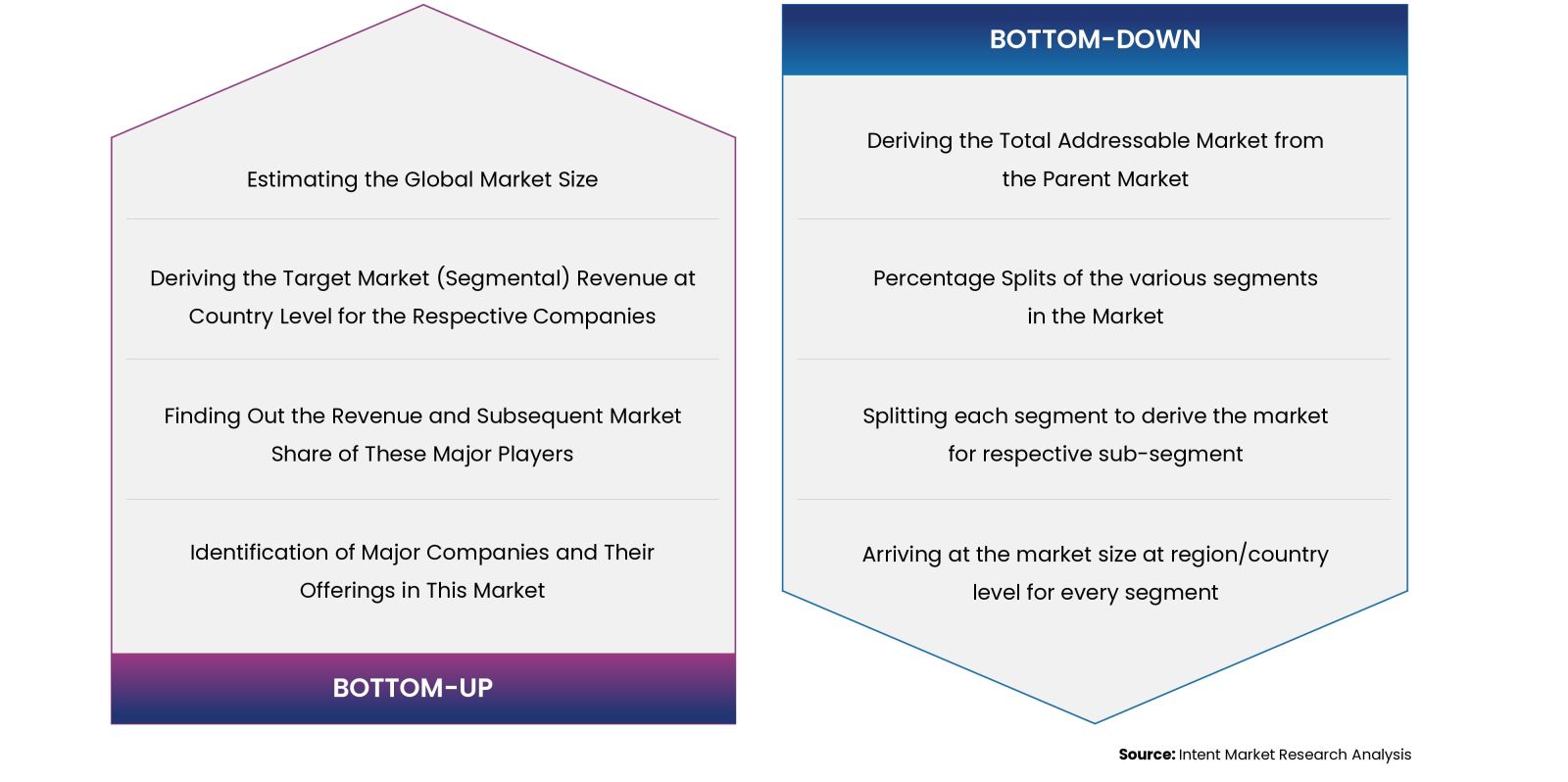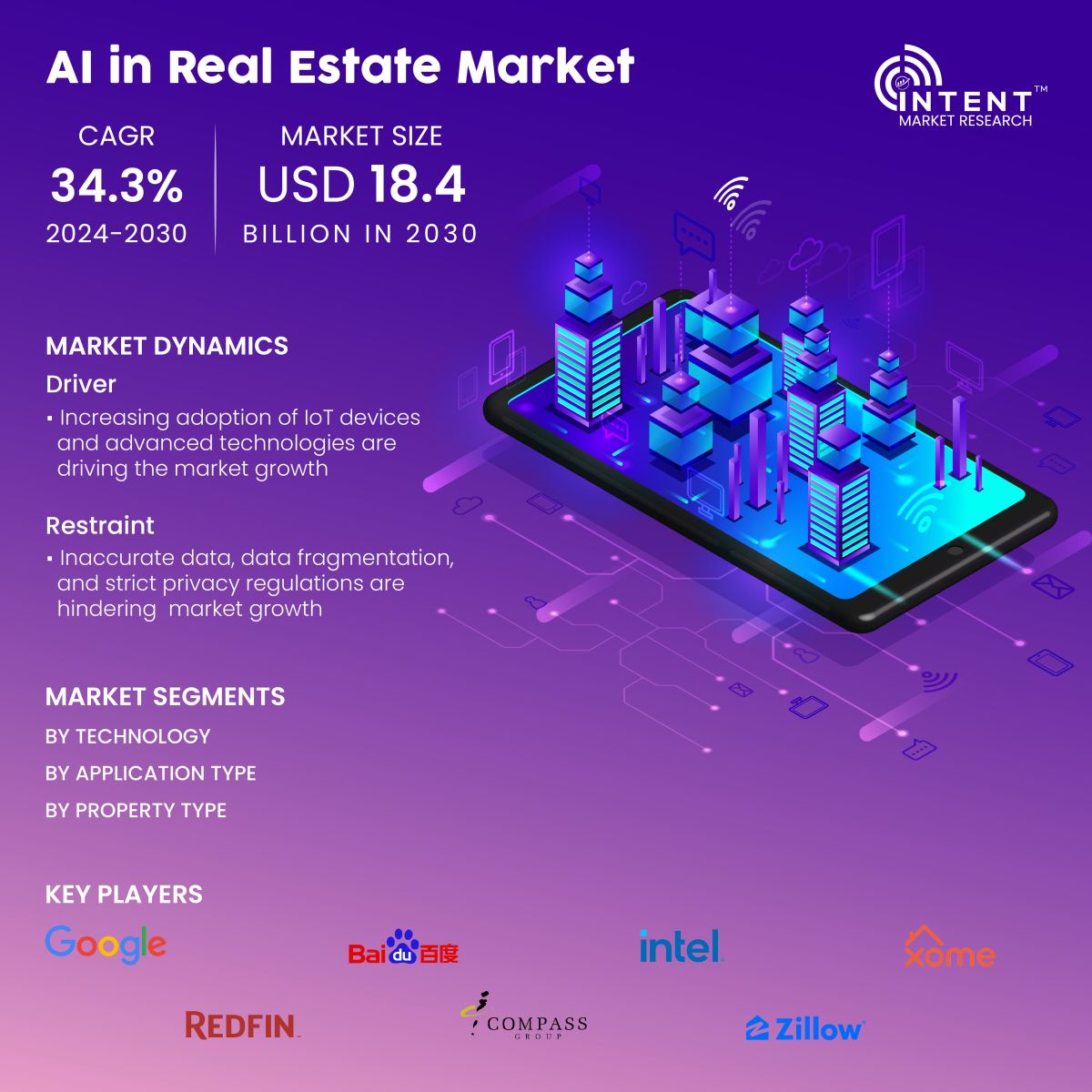As per Intent Market Research, the AI in real estate market size is expected to grow from USD 2.2 billion in 2023-e to USD 18.4 billion by 2030, at a CAGR of 34.3% during the forecast period (2024-2030). Key players in this market include Aalto, Baidu., Buildout, Compass, Endpoint, Evolve, Findigs, Google, Homebot, Intel, Keyway, Mint House, Mosaic Building, Nomad, OJO, Opendoor, Redfin, Redfin, Rex, Rhino, Stavvy, TestFit, The Rockport Group, The Guarantors, Truehold, Up&Up, Xome & Zillow. AI streamlines operations, reduces manual errors, and allows real estate professionals to focus on higher-value tasks thereby driving the market growth.
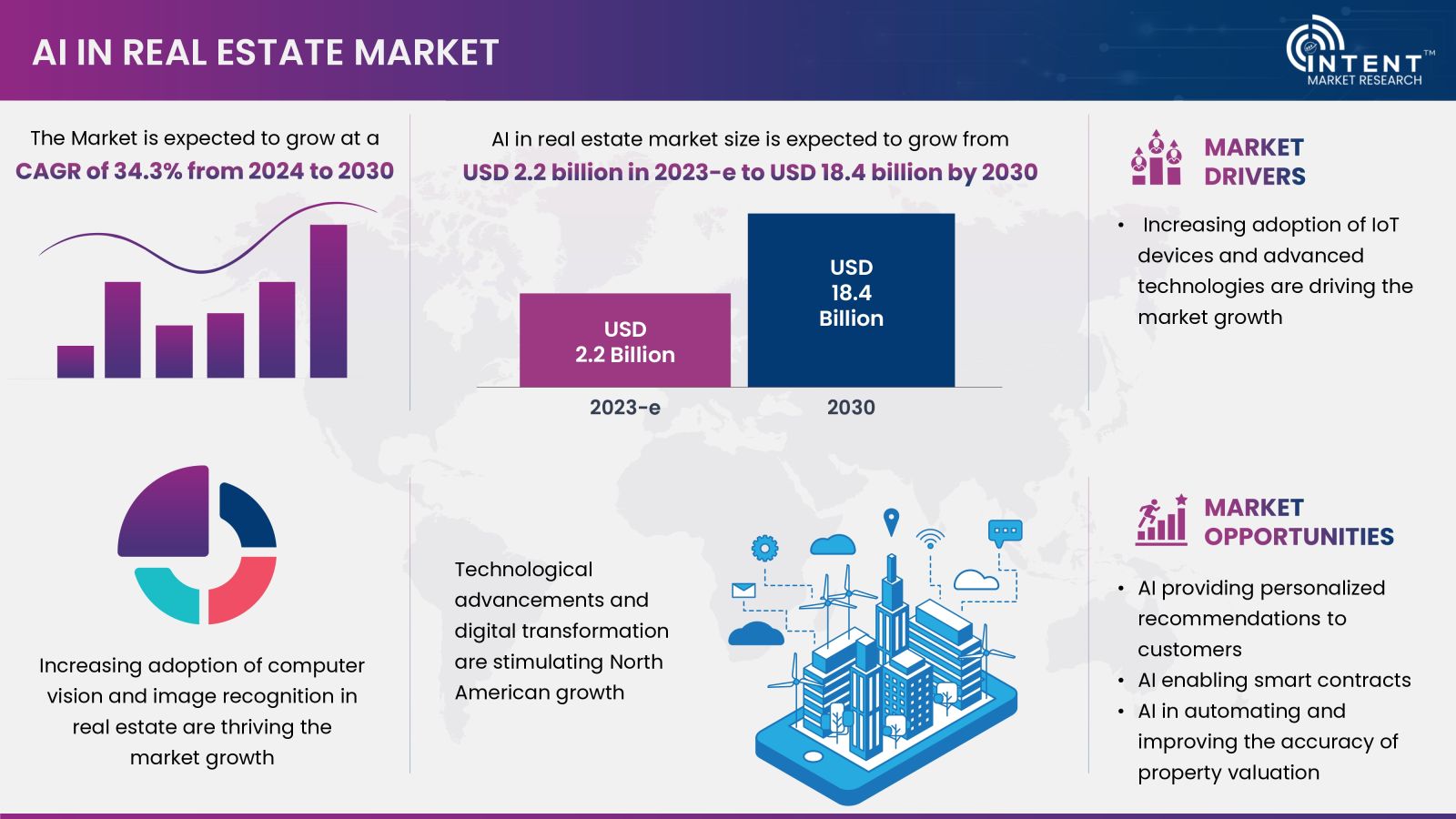
Click here to: Get FREE Sample Pages of this Report
Artificial Intelligence (AI) in real estate refers to the use of advanced computer algorithms and machine learning techniques to analyze and process large volumes of data in the real estate industry. AI technologies are employed to streamline and enhance various aspects of real estate operations, from property searches and valuation to property management and customer service. AI in the real estate sector strives to enhance efficiency, accuracy, and data-driven processes, ultimately providing benefits to real estate professionals, buyers, sellers, and investors.
AI in Real Estate Market Dynamics
Increasing Adoption of IoT Devices and Advanced Technologies are Driving the Market Growth
AI in real estate market growth is driven by the increasing adoption of IoT devices, advanced technologies such as big data and machine learning, smart devices, and internet services. The AI-powered Automated Valuation Models (AVMs) offer more accurate property valuations, helping buyers, sellers, and lenders make informed decisions. As per the Zillow reports AI-powered AVMs have reduced the median error rate in home value estimates to around 1.9% in the United States.
AI is employed to optimize energy usage in buildings, making properties more sustainable and energy-efficient. Integrating blockchain technology with AI enhances transparency and security in real estate transactions, minimizing fraud and errors. The real estate technology sector (PropTech) has seen significant investment and innovation, with AI playing a central role in this growth.
AI in Real Estate Market Segmental Insights
Increasing Adoption of Computer Vision and Image Recognition in Real Estate are Thriving the Market Growth
Computer vision and image recognition technologies are essential in the real estate industry, elevating property valuation, search processes, marketing strategies, and overall customer experiences. These technologies improve automated property valuation models, allowing for immersive virtual tours and personalized recommendations. For instance, Restb.ai introduced a New Valuation Product Suite in August 2023, aiming to modernize property appraisals and streamline inspections with the introduction of new GSE standards. The visual-centric nature of the real estate industry and advancements in cloud computing and storage have made it easier to apply these technologies, making them a significant presence in the AI landscape of the real estate market.
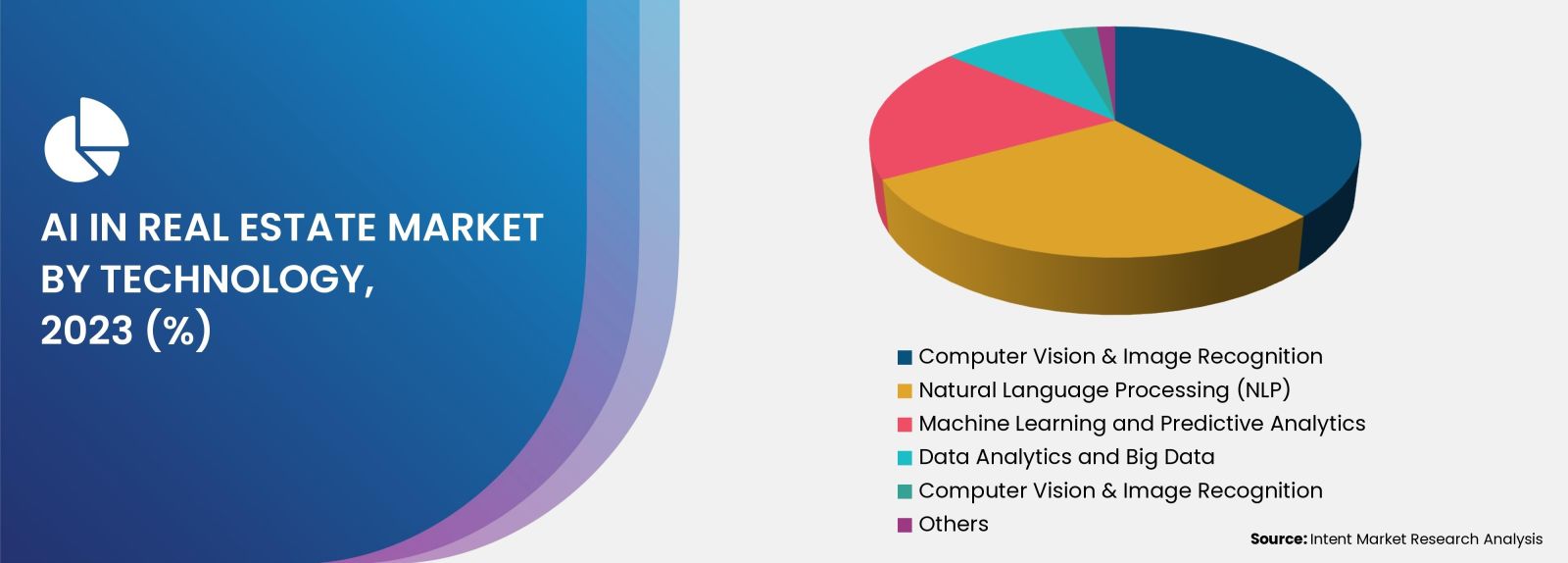
Facility management and Smart Buildings are Enhancing the Operational Efficiency & User Experience of Property
Facility management and smart buildings application segment is gaining popularity due to their energy efficiency, cost reduction, and maintenance efficiency. AI-based systems optimize energy consumption, predict maintenance, and improve building performance. Smart buildings offer comfort, security, and revenue generation, making them attractive to tenants and buyers in competitive markets. Spacewell and TCM IP Services collaborated to elevate user experiences and optimize energy consumption, offering seamless, intuitive solutions for building owners and occupants. Artificial intelligence (AI) adoption in facility management and smart buildings propels real estate market growth by enhancing operational efficiency and user experiences for property owners, managers, and tenants.
AI is Revolutionizing the Commercial Real Estate Sector
AI is revolutionizing commercial real estate by providing increased operational efficiency, reduced costs, and improved decision-making. AI plays a role in assessing and mitigating investment risks, optimizing energy consumption, and enhancing the competitiveness of properties. It can also assist in compliance and due diligence processes by automating document review, contract analysis, and regulatory compliance checks. Henceforth, AI adoption in commercial real estate boosts efficiency, reduces costs, improves decision-making, and offers modern, tech-enabled spaces, with its role expected to grow further as AI advances.
Regional Insights
Technological Advancements and Digital Transformation are Stimulating North America Growth
North America's AI market in real estate is experiencing significant growth due to technological advancements and digital transformation in the construction industry. North America, particularly the US, has seen significant investment in real estate technology, particularly AI-driven solutions, reaching USD 23.8 billion in 2021. Incorporating residential, commercial, and industrial properties, North America presents opportunities for AI-driven applications within a diverse market.
Major technology hubs such as Silicon Valley, Boston, and New York are at the forefront of AI innovation in the real estate industry. High expectations for technology-driven amenities and services in real estate include smart buildings, efficient property management, and personalized experiences. The region's economic activity and dynamic real estate market provide fertile ground for , offering efficiency, cost savings, and better decision-making. The North American real estate sector is integrating AI technologies to enhance productivity, safety, and project outcomes, with a growing ecosystem of providers, firms, and research institutions which is driving the regional growth.
Competitive Landscape
Product Innovation is the Key Strategy Adopted by Major Market Players
Key players in this market include Aalto, Baidu, Buildout, Compass, Endpoint, Evolve, Findigs,Google, Homebot, Intel, Keyway, Mint House, Mosaic Building, Nomad, OJO, Opendoor, Redfin, Redfin, Rex, Rhino, Stavvy, TestFit, The Rockport Group, The Guarantors, Truehold, Up&Up, Xome & Zillow. These industry leaders are focused on continuous innovation to meet the evolving preferences and needs of consumers. The ability to adapt to changing market trends and consumer preferences is crucial for success in the market. For instance, On Aug. 30, 2023, Backflip announced the launch of My Leads, an AI-enabled property-sourcing feature
Click here to: Get your custom research report today
AI in Real Estate Market Coverage
The report provides key insights into the AI in the real estate market, and it focuses on technological developments, trends, and initiatives taken by the government in this sector. The analysis explores the AI Real Estate market, highlighting factors such as market drivers, restraints, and opportunities. It also scrutinizes key players and the competitive landscape within the industry.
.jpg)
Report Scope
|
Report Features |
Description |
|
Market Size (2023-e) |
USD 2.2 billion |
|
Forecast Revenue (2030) |
USD 18.4 billion |
|
CAGR (2024-2030) |
34.3% |
|
Base Year for Estimation |
2023-e |
|
Historic Year |
2022 |
|
Forecast Period |
2024-2030 |
|
Report Coverage |
Revenue Forecast, Market Dynamics, Competitive Landscape, Recent Developments |
|
Segments Covered |
By Technology (Natural Language Processing (NLP), Machine Learning & Predictive Analytics, Data Analytics & Big Data, Computer Vision & Image Recognition, Others), By Application Type (Virtual Property Tours & Visualization, Property Management & Maintenance, Facility Management & Smart Buildings, Property Valuation & Appraisal, Others), By Property Type (Residential Real Estate, Commercial Real Estate) |
|
Regional Analysis |
North America (US, Canada), Europe (Germany, France, UK, Spain, Italy), Asia-Pacific (China, Japan, South Korea, India), Latin America (Brazil, Mexico, Argentina), Middle East & Africa (Saudi Arabia, South Africa, Turkey, United Arab Emirates) |
|
Competitive Landscape |
Aalto, Baidu, Buildout, Compass, Endpoint, Evolve, Findigs, Google, Homebot, Intel, Keyway, Mint House, Mosaic Building, Nomad, OJO, Opendoor, Redfin, Redfin, Rex, Rhino, Stavvy, TestFit, The Rockport Group, The Guarantors, Truehold, Up&Up, Xome & Zillow. |
|
Customization Scope |
Customization for segments, region/country-level will be provided. Moreover, additional customization can be done based on the requirements. |
|
Purchase Options |
We have three licenses to opt for Single User License, Multi-User License (Up to 5 Users), Corporate Use License (Unlimited User and Printable PDF) |
|
1. Introduction |
|
1. 1. Study Assumptions and AI in Real Estate Market Definition |
|
1.2. Scope of the Study |
|
2. Research Methodology |
|
3. Executive Summary |
|
4. AI in Real Estate Market Dynamics |
|
4.1. Market Growth Drivers |
|
4.2 Market Growth Challenges |
|
5. AI in Real Estate Market Outlook |
|
5.1. Use Case studies |
|
5.2 AI is revolutionizing the residential real estate industry |
|
5.3. The Impact of AI on Commercial Real Estate |
|
5.4 AI is shaping the future of real estate: Opportunity Analysis |
|
5.5. The ethics of artificial intelligence: Issues and initiatives |
|
5.6. Porter's Five forces |
|
5.7 Pestle Analysis |
|
5.8 BCG Matrix Analysis |
|
5.9 Investment Analysis |
|
6. Global AI in Real Estate Market Segmentation (Market Size and Forecast by Value - USD billion, 2024 - 2030) |
|
6.1 Technology |
|
6.1.1 Natural Language Processing (NLP) |
|
6.1.2 Machine Learning and Predictive Analytics |
|
6.1.3 Data Analytics and Big Data |
|
6.1.4 Computer Vision & Image Recognition |
|
6.1.5 Others |
|
6.2 Application Type |
|
6.2.1 Virtual Property Tours and Visualization |
|
6.2.2 Property Management and Maintenance |
|
6.2.3 Facility Management and Smart Building |
|
6.2.4 Property Valuation and Appraisal |
|
6.2.5 Others |
|
6.3 Property Type |
|
6.3.1 Residential Real Estate |
|
6.3.2 Commercial Real Estate |
|
6.4 Region |
|
6.4.1 North America |
|
6.4.2 Europe |
|
6.4.3 Asia-Pacific |
|
6.4.4 Latin America |
|
6.4.5 Middle East and Africa |
|
7. North America AI in Real Estate Market Segmentation (Market Size and Forecast by Value - USD billion, 2024 - 2030) |
|
7.1 Technology |
|
7.1.1 Natural Language Processing (NLP) |
|
7.1.2 Machine Learning and Predictive Analytics |
|
7.1.3 Data Analytics and Big Data |
|
7.1.4 Computer Vision & Image Recognition |
|
7.1.5 Others |
|
7.2 Application Type |
|
7.2.1 Virtual Property Tours and Visualization |
|
7.2.2 Property Management and Maintenance |
|
7.2.3 Facility Management and Smart Building |
|
7.2.4 Property Valuation and Appraisal |
|
7.2.5 Others |
|
7.3 Property Type |
|
7.3.1 Residential Real Estate |
|
7.3.2 Commercial Real Estate |
|
7.4 Country |
|
7.4.1 United States |
|
7.4.1.1 Technology |
|
7.4.1.1.1 Natural Language Processing (NLP) |
|
7.4.1.1.2 Machine Learning and Predictive Analytics |
|
7.4.1.1.3 Data Analytics and Big Data |
|
7.4.1.1.4 Computer Vision & Image Recognition |
|
7.4.1.1.5 Others |
|
7.4.1.2 Application Type |
|
7.4.1.2.1 Virtual Property Tours and Visualization |
|
7.4.1.2.2 Property Management and Maintenance |
|
7.4.1.2.3 Facility Management and Smart Building |
|
7.4.1.2.4 Computer Vision & Image Recognition |
|
7.4.1.2.5 Others |
|
7.4.1.3 Property Type |
|
7.4.1.3.1 Residential Real Estate |
|
7.4.1.3.2 Commercial Real Estate |
|
7.4.2 Canada |
|
7.4.2.1 Technology |
|
7.4.2.1.1 Natural Language Processing (NLP) |
|
7.4.2.1.2 Machine Learning and Predictive Analytics |
|
7.4.2.1.3 Data Analytics and Big Data |
|
7.4.2.1.4 Computer Vision & Image Recognition |
|
7.4.2.1.5 Others |
|
7.4.2.2 Application Type |
|
7.4.2.2.1 Virtual Property Tours and Visualization |
|
7.4.2.2.2 Property Management and Maintenance |
|
7.4.2.2.3 Facility Management and Smart Building |
|
7.4.2.2.4 Computer Vision & Image Recognition |
|
7.4.2.2.5 Others |
|
7.4.2.3 Property Type |
|
7.4.2.3.1 Residential Real Estate |
|
7.4.2.3.2 Commercial Real Estate |
|
8. Europe Market AI in Real Estate Segmentation (Market Size and Forecast by Value - USD billion, 2024 - 2030) |
|
8.1 Technology |
|
8.1.1 Natural Language Processing (NLP) |
|
8.1.2 Machine Learning and Predictive Analytics |
|
8.1.3 Data Analytics and Big Data |
|
8.1.4 Computer Vision & Image Recognition |
|
8.1.5 Others |
|
8.2 Application Type |
|
8.2.1 Virtual Property Tours and Visualization |
|
8.2.2 Property Management and Maintenance |
|
8.2.3 Facility Management and Smart Building |
|
8.2.4 Property Valuation and Appraisal |
|
8.2.5 Others |
|
8.3 Property Type |
|
8.3.1 Residential Real Estate |
|
8.3.2 Commercial Real Estate |
|
8.4 Country |
|
8.4.1 United Kingdom |
|
8.4.1.1 Technology |
|
8.4.1.1.1 Natural Language Processing (NLP) |
|
8.4.1.1.2 Machine Learning and Predictive Analytics |
|
8.4.1.1.3 Data Analytics and Big Data |
|
8.4.1.1.4 Computer Vision & Image Recognition |
|
8.4.1.1.5 Others |
|
8.4.1.2 Application Type |
|
8.4.1.2.1 Virtual Property Tours and Visualization |
|
8.4.1.2.2 Property Management and Maintenance |
|
8.4.1.2.3 Facility Management and Smart Building |
|
8.4.1.2.4 Computer Vision & Image Recognition |
|
8.4.1.2.5 Others |
|
8.4.1.3 Property Type |
|
8.4.1.3.1 Residential Real Estate |
|
8.4.1.3.2 Commercial Real Estate |
|
8.4.2 France |
|
8.4.2.1 Technology |
|
8.4.2.1.1 Natural Language Processing (NLP) |
|
8.4.2.1.2 Machine Learning and Predictive Analytics |
|
8.4.2.1.3 Data Analytics and Big Data |
|
8.4.2.1.4 Computer Vision & Image Recognition |
|
8.4.2.1.5 Others |
|
8.4.2.2 Application Type |
|
8.4.2.2.1 Virtual Property Tours and Visualization |
|
8.4.2.2.2 Property Management and Maintenance |
|
8.4.2.2.3 Facility Management and Smart Building |
|
8.4.2.2.4 Computer Vision & Image Recognition |
|
8.4.2.2.5 Others |
|
8.4.2.3 Property Type |
|
8.4.2.3.1 Residential Real Estate |
|
8.4.2.3.2 Commercial Real Estate |
|
8.4.3 Germany |
|
8.4.3.1 Technology |
|
8.4.3.1.1 Natural Language Processing (NLP) |
|
8.4.3.1.2 Machine Learning and Predictive Analytics |
|
8.4.3.1.3 Data Analytics and Big Data |
|
8.4.3.1.4 Computer Vision & Image Recognition |
|
8.4.3.1.5 Others |
|
8.4.3.2 Application Type |
|
8.4.3.2.1 Virtual Property Tours and Visualization |
|
8.4.3.2.2 Property Management and Maintenance |
|
8.4.3.2.3 Facility Management and Smart Building |
|
8.4.3.2.4 Computer Vision & Image Recognition |
|
8.4.3.2.5 Others |
|
8.4.3.3 Property Type |
|
8.4.3.3.1 Residential Real Estate |
|
8.4.3.3.2 Commercial Real Estate |
|
8.4.4 Italy |
|
8.4.4.1 Technology |
|
8.4.4.1.1 Natural Language Processing (NLP) |
|
8.4.4.1.2 Machine Learning and Predictive Analytics |
|
8.4.4.1.3 Data Analytics and Big Data |
|
8.4.4.1.4 Computer Vision & Image Recognition |
|
8.4.4.1.5 Others |
|
8.4.4.2 Application Type |
|
8.4.4.2.1 Virtual Property Tours and Visualization |
|
8.4.4.2.2 Property Management and Maintenance |
|
8.4.4.2.3 Facility Management and Smart Building |
|
8.4.4.2.4 Computer Vision & Image Recognition |
|
8.4.4.2.5 Others |
|
8.4.4.3 Property Type |
|
8.4.4.3.1 Residential Real Estate |
|
8.4.4.3.2 Commercial Real Estate |
|
9. Asia Pacific AI in Real Estate Market Segmentation (Market Size and Forecast by Value - USD billion, 2024 - 2030) |
|
9.1 Technology |
|
9.1.1 Natural Language Processing (NLP) |
|
9.1.2 Machine Learning and Predictive Analytics |
|
9.1.3 Data Analytics and Big Data |
|
9.1.4 Computer Vision & Image Recognition |
|
9.1.5 Others |
|
9.2 Application Type |
|
9.2.1 Virtual Property Tours and Visualization |
|
9.2.2 Property Management and Maintenance |
|
9.2.3 Facility Management and Smart Building |
|
9.2.4 Property Valuation and Appraisal |
|
9.2.5 Others |
|
9.3 Property Type |
|
9.3.1 Residential Real Estate |
|
9.3.2 Commercial Real Estate |
|
9.4 Country |
|
9.4.1 China |
|
9.4.1.1 Technology |
|
9.4.1.1.1 Natural Language Processing (NLP) |
|
9.4.1.1.2 Machine Learning and Predictive Analytics |
|
9.4.1.1.3 Data Analytics and Big Data |
|
9.4.1.1.4 Computer Vision & Image Recognition |
|
9.4.1.1.5 Others |
|
9.4.1.2 Application Type |
|
9.4.1.2.1 Virtual Property Tours and Visualization |
|
9.4.1.2.2 Property Management and Maintenance |
|
9.4.1.2.3 Facility Management and Smart Building |
|
9.4.1.2.4 Computer Vision & Image Recognition |
|
9.4.1.2.5 Others |
|
9.4.1.3 Property Type |
|
9.4.1.3.1 Residential Real Estate |
|
9.4.1.3.2 Commercial Real Estate |
|
9.4.2 Japan |
|
9.4.2.1 Technology |
|
9.4.2.1.1 Natural Language Processing (NLP) |
|
9.4.2.1.2 Machine Learning and Predictive Analytics |
|
9.4.2.1.3 Data Analytics and Big Data |
|
9.4.2.1.4 Computer Vision & Image Recognition |
|
9.4.2.1.5 Others |
|
9.4.2.2 Application Type |
|
9.4.2.2.1 Virtual Property Tours and Visualization |
|
9.4.2.2.2 Property Management and Maintenance |
|
9.4.2.2.3 Facility Management and Smart Building |
|
9.4.2.2.4 Computer Vision & Image Recognition |
|
9.4.2.2.5 Others |
|
9.4.2.3 Property Type |
|
9.4.2.3.1 Residential Real Estate |
|
9.4.2.3.2 Commercial Real Estate |
|
9.4.3 India |
|
9.4.3.1 Technology |
|
9.4.3.1.1 Natural Language Processing (NLP) |
|
9.4.3.1.2 Machine Learning and Predictive Analytics |
|
9.4.3.1.3 Data Analytics and Big Data |
|
9.4.3.1.4 Computer Vision & Image Recognition |
|
9.4.3.1.5 Others |
|
9.4.3.2 Application Type |
|
9.4.3.2.1 Virtual Property Tours and Visualization |
|
9.4.3.2.2 Property Management and Maintenance |
|
9.4.3.2.3 Facility Management and Smart Building |
|
9.4.3.2.4 Computer Vision & Image Recognition |
|
9.4.3.2.5 Others |
|
9.4.3.3 Property Type |
|
9.4.3.3.1 Residential Real Estate |
|
9.4.3.3.2 Commercial Real Estate |
|
9.4.4 South Korea |
|
9.4.4.1 Technology |
|
9.4.4.1.1 Natural Language Processing (NLP) |
|
9.4.4.1.2 Machine Learning and Predictive Analytics |
|
9.4.4.1.3 Data Analytics and Big Data |
|
9.4.4.1.4 Computer Vision & Image Recognition |
|
9.4.4.1.5 Others |
|
9.4.4.2 Application Type |
|
9.4.4.2.1 Virtual Property Tours and Visualization |
|
9.4.4.2.2 Property Management and Maintenance |
|
9.4.4.2.3 Facility Management and Smart Building |
|
9.4.4.2.4 Computer Vision & Image Recognition |
|
9.4.4.2.5 Others |
|
9.4.4.3 Property Type |
|
9.4.4.3.1 Residential Real Estate |
|
9.4.4.3.2 Commercial Real Estate |
|
10. Latin America AI in Real Estate Market Segmentation (Market Size and Forecast by Value - USD billion, 2024 - 2030) |
|
10.1 Technology |
|
10.1.1 Natural Language Processing (NLP) |
|
10.1.2 Machine Learning and Predictive Analytics |
|
10.1.3 Data Analytics and Big Data |
|
10.1.4 Computer Vision & Image Recognition |
|
10.1.5 Others |
|
10.2 Application Type |
|
10.2.1 Virtual Property Tours and Visualization |
|
10.2.2 Property Management and Maintenance |
|
10.2.3 Facility Management and Smart Building |
|
10.2.4 Property Valuation and Appraisal |
|
10.2.5 Others |
|
10.3 Property Type |
|
10.3.1 Residential Real Estate |
|
10.3.2 Commercial Real Estate |
|
10.4 Country |
|
10.4.1 Brazil |
|
10.4.1.1 Technology |
|
10.4.1.1.1 Natural Language Processing (NLP) |
|
10.4.1.1.2 Machine Learning and Predictive Analytics |
|
10.4.1.1.3 Data Analytics and Big Data |
|
10.4.1.1.4 Computer Vision & Image Recognition |
|
10.4.1.1.5 Others |
|
10.4.1.2 Application Type |
|
10.4.1.2.1 Virtual Property Tours and Visualization |
|
10.4.1.2.2 Property Management and Maintenance |
|
10.4.1.2.3 Facility Management and Smart Building |
|
10.4.1.2.4 Computer Vision & Image Recognition |
|
10.4.1.2.5 Others |
|
10.4.1.3 Property Type |
|
10.4.1.3.1 Residential Real Estate |
|
10.4.1.3.2 Commercial Real Estate |
|
10.4.2 Mexico |
|
10.4.2.1 Technology |
|
10.4.2.1.1 Natural Language Processing (NLP) |
|
10.4.2.1.2 Machine Learning and Predictive Analytics |
|
10.4.2.1.3 Data Analytics and Big Data |
|
10.4.2.1.4 Computer Vision & Image Recognition |
|
10.4.2.1.5 Others |
|
10.4.2.2 Application Type |
|
10.4.2.2.1 Virtual Property Tours and Visualization |
|
10.4.2.2.2 Property Management and Maintenance |
|
10.4.2.2.3 Facility Management and Smart Building |
|
10.4.2.2.4 Computer Vision & Image Recognition |
|
10.4.2.2.5 Others |
|
10.4.2.3 Property Type |
|
10.4.2.3.1 Residential Real Estate |
|
10.4.2.3.2 Commercial Real Estate |
|
10.4.3 Argentina |
|
10.4.3.1 Technology |
|
10.4.3.1.1 Natural Language Processing (NLP) |
|
10.4.3.1.2 Machine Learning and Predictive Analytics |
|
10.4.3.1.3 Data Analytics and Big Data |
|
10.4.3.1.4 Computer Vision & Image Recognition |
|
10.4.3.1.5 Others |
|
10.4.3.2 Application Type |
|
10.4.3.2.1 Virtual Property Tours and Visualization |
|
10.4.3.2.2 Property Management and Maintenance |
|
10.4.3.2.3 Facility Management and Smart Building |
|
10.4.3.2.4 Computer Vision & Image Recognition |
|
10.4.3.2.5 Others |
|
10.4.3.3 Property Type |
|
10.4.3.3.1 Residential Real Estate |
|
10.4.3.3.2 Commercial Real Estate |
|
11. Middle East & Africa AI in Real Estate Market Segmentation (Market Size and Forecast by Value - USD billion, 2024 - 2030) |
|
11.1 Technology |
|
11.1.1 Natural Language Processing (NLP) |
|
11.1.2 Machine Learning and Predictive Analytics |
|
11.1.3 Data Analytics and Big Data |
|
11.1.4 Computer Vision & Image Recognition |
|
11.1.5 Others |
|
11.2 Application Type |
|
11.2.1 Virtual Property Tours and Visualization |
|
11.2.2 Property Management and Maintenance |
|
11.2.3 Facility Management and Smart Building |
|
11.2.4 Property Valuation and Appraisal |
|
11.2.5 Others |
|
11.3 Property Type |
|
11.3.1 Residential Real Estate |
|
11.3.2 Commercial Real Estate |
|
11.4 Country |
|
11.4.1 United Arab Emirates |
|
11.4.1.1 Technology |
|
11.4.1.1.1 Natural Language Processing (NLP) |
|
11.4.1.1.2 Machine Learning and Predictive Analytics |
|
11.4.1.1.3 Data Analytics and Big Data |
|
11.4.1.1.4 Computer Vision & Image Recognition |
|
11.4.1.1.5 Others |
|
11.4.1.2 Application Type |
|
11.4.1.2.1 Virtual Property Tours and Visualization |
|
11.4.1.2.2 Property Management and Maintenance |
|
11.4.1.2.3 Facility Management and Smart Building |
|
11.4.1.2.4 Computer Vision & Image Recognition |
|
11.4.1.2.5 Others |
|
11.4.1.3 Property Type |
|
11.4.1.3.1 Residential Real Estate |
|
11.4.1.3.2 Commercial Real Estate |
|
11.4.2 Saudi Arabia |
|
11.4.2.1 Technology |
|
11.4.2.1.1 Natural Language Processing (NLP) |
|
11.4.2.1.2 Machine Learning and Predictive Analytics |
|
11.4.2.1.3 Data Analytics and Big Data |
|
11.4.2.1.4 Computer Vision & Image Recognition |
|
11.4.2.1.5 Others |
|
11.4.2.2 Application Type |
|
11.4.2.2.1 Virtual Property Tours and Visualization |
|
11.4.2.2.2 Property Management and Maintenance |
|
11.4.2.2.3 Facility Management and Smart Building |
|
11.4.2.2.4 Computer Vision & Image Recognition |
|
11.4.2.2.5 Others |
|
11.4.2.3 Property Type |
|
11.4.2.3.1 Residential Real Estate |
|
11.4.2.3.2 Commercial Real Estate |
|
11.4.3 South Africa |
|
11.4.3.1 Technology |
|
11.4.3.1.1 Natural Language Processing (NLP) |
|
11.4.3.1.2 Machine Learning and Predictive Analytics |
|
11.4.3.1.3 Data Analytics and Big Data |
|
11.4.3.1.4 Computer Vision & Image Recognition |
|
11.4.3.1.5 Others |
|
11.4.3.2 Application Type |
|
11.4.3.2.1 Virtual Property Tours and Visualization |
|
11.4.3.2.2 Property Management and Maintenance |
|
11.4.3.2.3 Facility Management and Smart Building |
|
11.4.3.2.4 Computer Vision & Image Recognition |
|
11.4.3.2.5 Others |
|
11.4.3.3 Property Type |
|
11.4.3.3.1 Residential Real Estate |
|
11.4.3.3.2 Commercial Real Estate |
|
12. Competitive Landscape |
|
12.1 Company Market Share Analysis |
|
12.2 Competitive Matrix |
|
12.2 Product Benchmarking |
|
12.3 Company Profiles (Manufacturers of AI in Real Estate) |
|
12.3.1 Intel Corporation |
|
12.3.1.1 Company Synopsis |
|
12.3.1.2 Company Financials |
|
12.3.1.3 Product/ Service Portfolio |
|
12.3.1.4 Recent Developments |
|
12.3.2 Compass Group |
|
12.3.3 Google |
|
12.3.4 Xome |
|
12.3.5 Redfin |
|
12.3.6 Zillow |
|
12.3.7 Baidu Inc. |
|
12.3.8 Homebot |
|
12.3.9 Stavvy |
|
12.3.10 Evolve |
|
12.3.11 Keyway |
|
12.3.12 Buildout, Inc. |
|
12.3.13 Endpoint |
|
12.3.14 View Profile. |
|
12.3.15 Findigs, Inc. |
|
12.4 Company Profiles (Demand Side) |
|
12.4.1 CBRE Group, Inc. |
|
12.4.1.1 Company Synopsis |
|
12.3.1.2 Company Financials |
|
12.3.1.3 Product/ Service Portfolio |
|
12.3.1.4 Recent Developments |
|
12.4.2 JLL (Jones Lang LaSalle) |
|
12.4.3 Colliers International |
|
12.4.4 Cushman & Wakefield |
|
12.4.5 Brookfield Asset Management |
|
13. Analyst Recommendations |
Intent Market Research employs a rigorous methodology to minimize residual errors by carefully defining the scope, validating findings through primary research, and consistently updating our in-house database. This dynamic approach allows us to capture ongoing market fluctuations and adapt to evolving market uncertainties.
The research factors used in our methodology vary depending on the specific market being analyzed. To begin with, we incorporate both demand and supply side information into our model to identify and address market gaps. Additionally, we also employ approaches such as Macro-Indicator Analysis, Factor Analysis, Value Chain-Based Sizing, and forecasting to further increase the accuracy of the numbers and validate the findings.
Research Approach
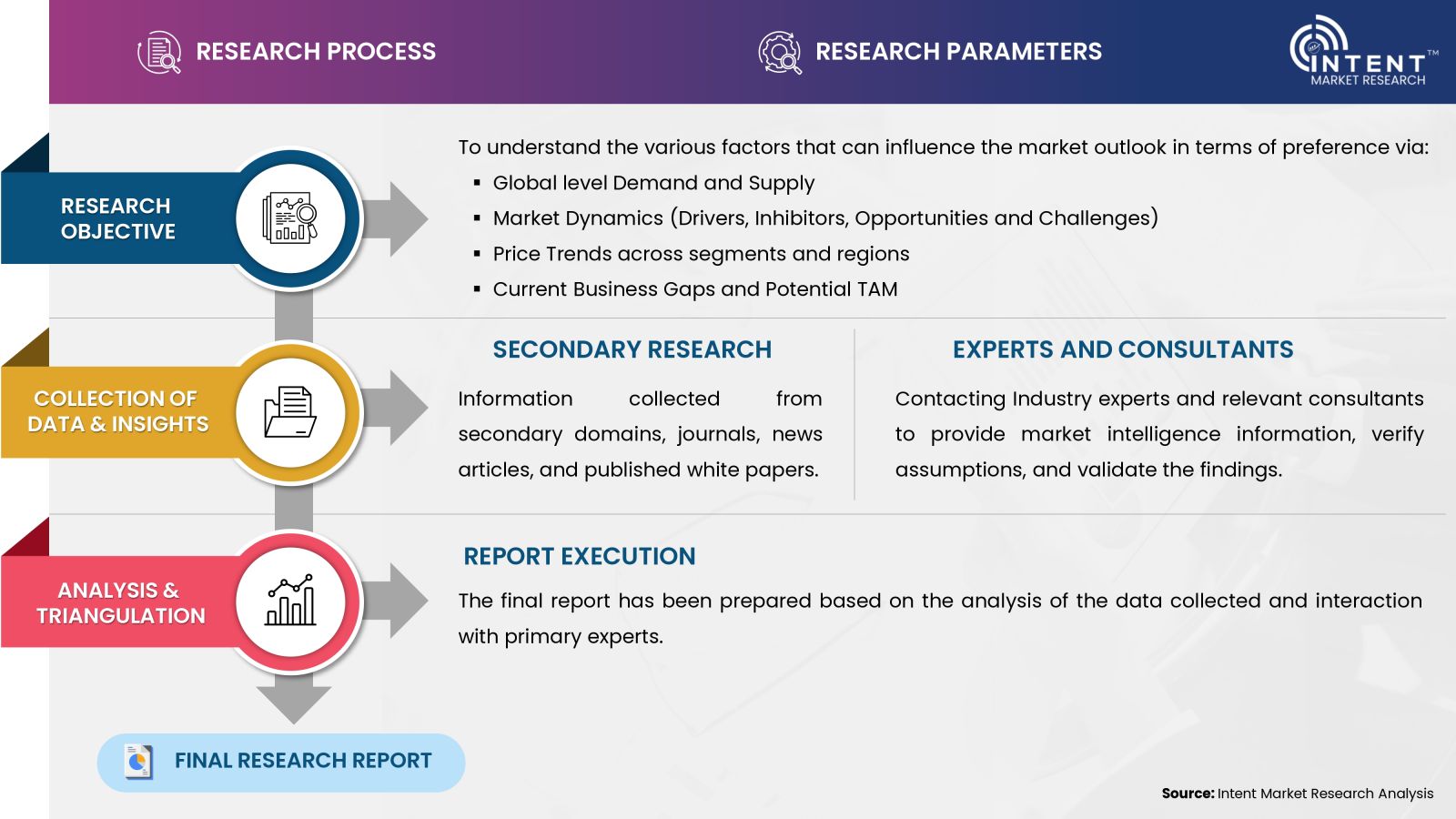
- Secondary Research Approach: During the initial phase of the research process, we acquire and accumulate extensive data continuously. This data is carefully filtered and validated through a variety of secondary sources.
- Primary Research Approach: Following the consolidation of data gathered through secondary research, we initiate a validation process to verify all the market numbers, and assumptions and validate the findings by engaging with subject matter experts.
Data Collection, Analysis and Interpretation:
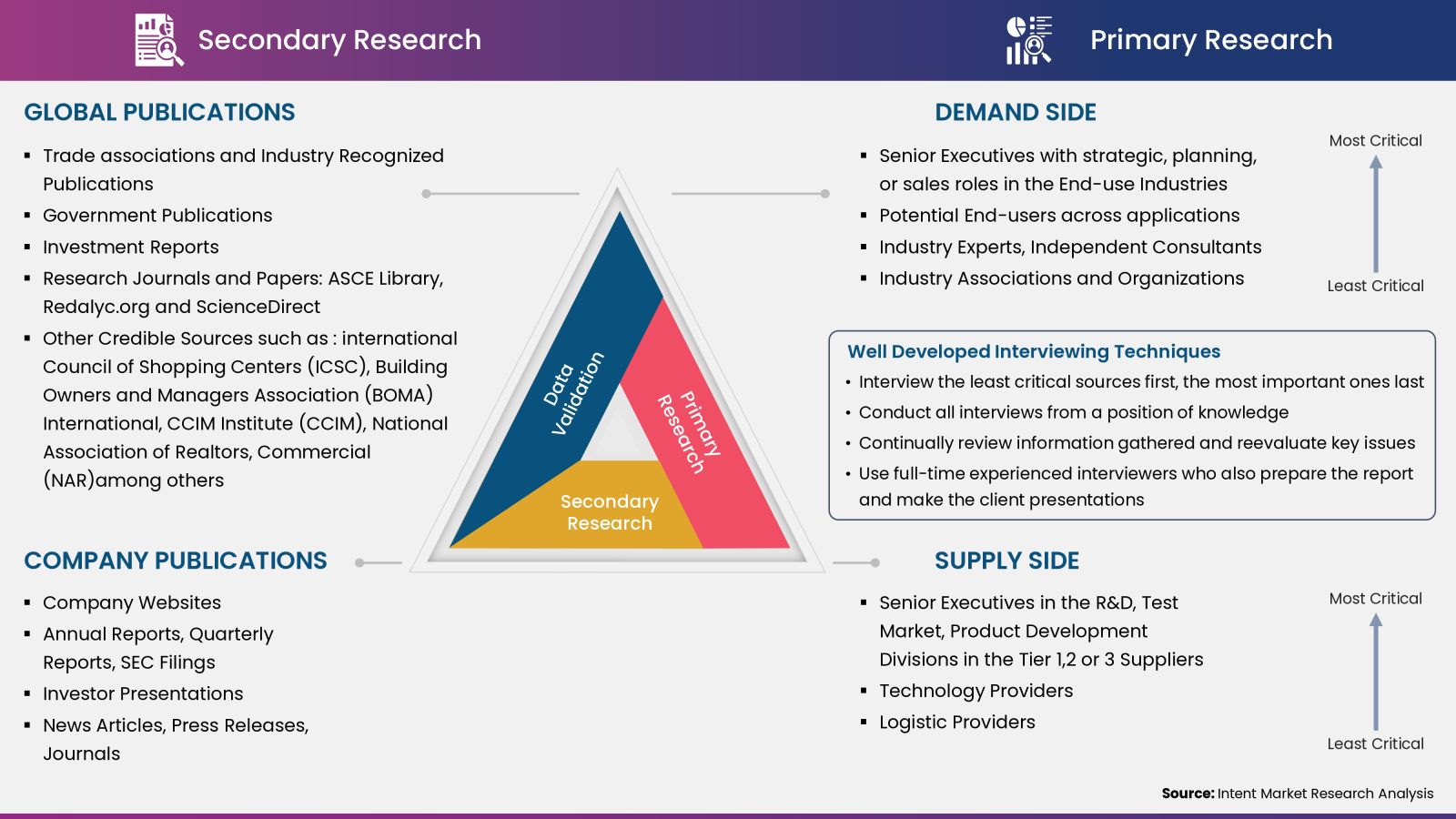
Research Methodology
Our market research methodology utilizes both top-down and bottom-up approaches to segment and estimate quantitative aspects of the market. We also employ multi-perspective analysis, examining the market from distinct viewpoints.
